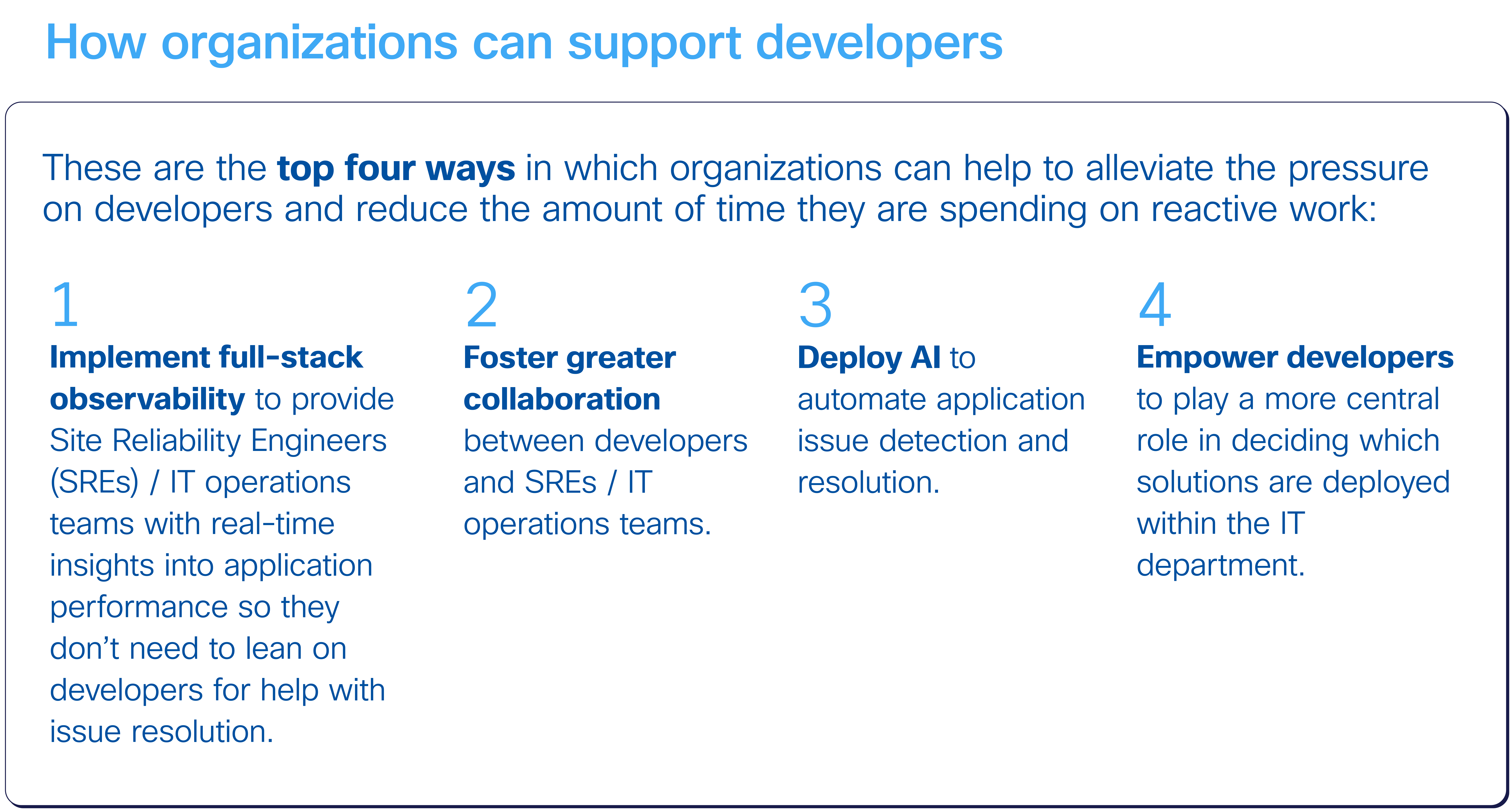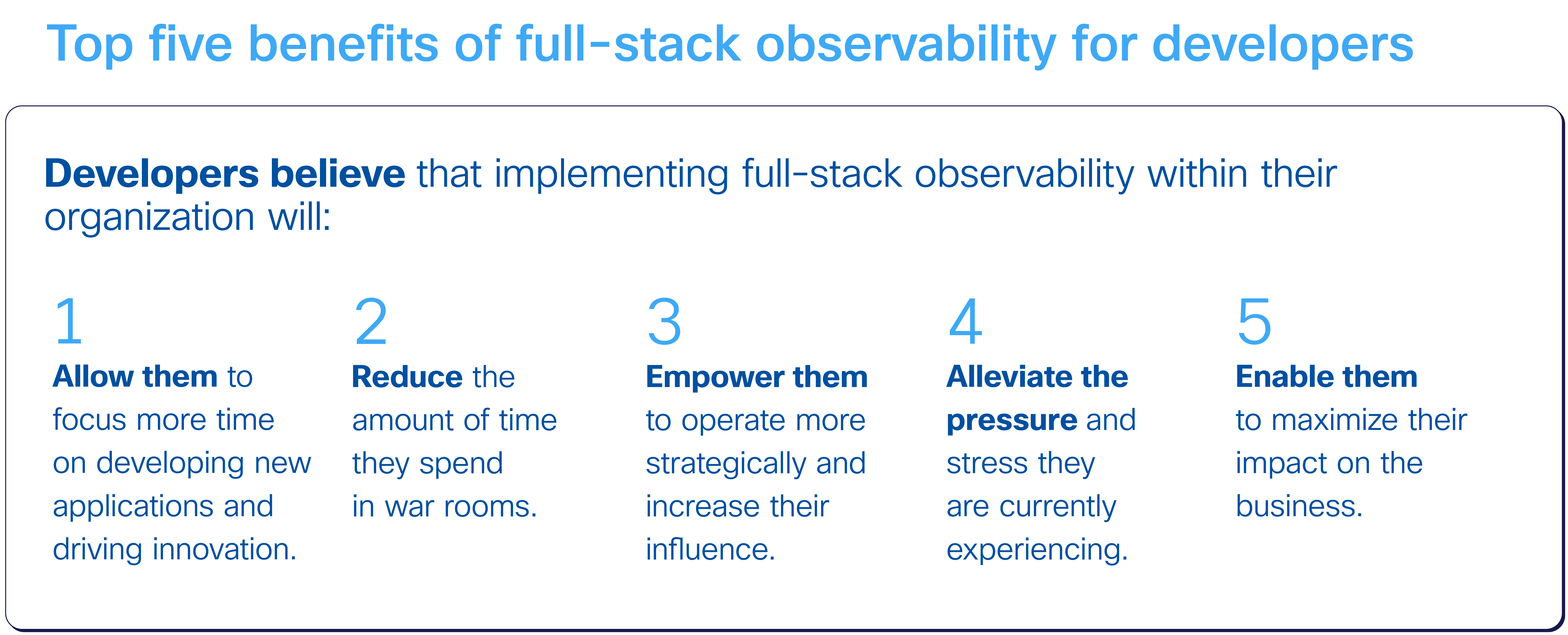From frustration to innovation: How full-stack observability can help developers escape war rooms and maximize impact
Introduction
Across all industries, developers are playing a critical role in building the applications and digital services that are now essential for organizations to drive competitive advantage and revenue growth. But unfortunately, many now find themselves operating under the most intense pressure.
Developers are being expected to deliver new tools and functionality at ever faster speeds; but, at the same time, they’re also facing endless demands to help operations teams manage the ongoing performance of applications - something which should not really be within their remit.

The upshot is that many developers are stuck in reactive mode, debugging applications instead of creating code and building new applications. They’re caught in a never-ending cycle of firefighting.
Unfortunately, this situation is having profound consequences at both an organizational and individual level. Organizations are becoming more vulnerable to application performance issues and less able to innovate at speed. Developers, meanwhile, are growing frustrated that they’re unable to prioritize the job they were hired to do.
At Cisco, we recognize the vital role that developers play in driving innovation, and we’re committed to helping them to overcome these current challenges. With this in mind, we conducted research amongst 500 global software developers to get their insights and, crucially, to learn how we can best support developers to maximize their impact and progress in their careers.
The research shows that developers have clear ideas about what their organizations can do to alleviate the pressure they find themselves under. When it comes to addressing the challenge of hours spent in war rooms, developers point to a need for their organizations to implement full-stack observability, to provide all technologists with unified visibility into availability, performance and security up and down the IT stack. They recognize how, with this level of insight, Site Reliability Engineers (SREs) and operations teams are easily able to identify, prioritize and resolve issues, without the need to constantly drag developers in to help.
Full-stack observability is viewed as a critical step in enabling developers to free themselves from endless debugging; and a catalyst for them to shift their focus onto what they’re actually paid to do - namely, writing the code and building the applications that will drive their businesses forward.

Lack of visibility means developers can’t escape war rooms
Alarmingly, the research finds that developers are, on average, currently spending 57% of their time on reactive work - such as debugging and attending war rooms - as opposed to developing new code and innovation-focused work.
Even once applications have passed into production and been launched, developers are being dragged into incident response meetings to deal with performance issues. This is largely because operations teams - whose job it is to manage applications and underlying infrastructure - don’t have the insights they need to easily detect issues and understand dependencies up and down the IT stack. To address performance issues, operations teams are having to pull in developers to understand how applications have been designed and built.
Much of the problem stems from the fact that within many IT departments, technologists are unable to generate a full and unified view into applications and the supporting stack. Organizations are deploying a multitude of monitoring tools across domains, but these tools are siloed and don’t provide IT teams with a complete picture across their IT environment.
As a result, developers are either spending large chunks of their time sitting in operational meetings that they don’t need to be in; or else they’re frantically scrambling to fix bugs and help operations teams avoid a catastrophic, revenue-impacting incident.

Understandably, the current situation is affecting morale, with 82% of developers admitting that they feel frustrated and demotivated, and 54% reporting that they are becoming more inclined to leave their job.
These findings should ring alarm bells for organizations who are now dependent on developers to create the compelling, intuitive digital experiences that are fundamental to meeting customer expectations and growing revenues. With demand for developer skills at an all-time high and a finite pool of talent, businesses should not be risking an exodus of talent simply because IT teams don't have the tools they need to do their jobs.

How developers can get back on the front foot
Developers are more than aware that there are cutting-edge tools available which could help them overcome some of the challenges they face and, what’s more, 91% feel that they should be playing a bigger role in shaping and deciding on the solutions needed within their organization.
Above all else, developers point to full-stack observability (FSO) as a potential game changer in enabling them to escape war rooms and focus more heavily on innovation. 78% of developers believe that implementing full-stack observability within their organization would be beneficial, allowing all technologists to get real-time insights into application performance across hybrid environments, and business context on that application data so that IT teams can prioritize the most important issues.
Developers themselves may not be the primary users of full-stack observability solutions - they tend to specialize in a particular domain, such as network or Storage I/O, and rely on specific tools to monitor these areas. However, they evidently recognize the benefits of having unified visibility across the IT estate. They can see how full-stack observability makes it much easier and quicker for SREs and operations teams to identify issues, understand root causes and carry out necessary remediation.
The knock-on effect is that SREs and operations teams don’t then need to call large numbers of technologists from across domain teams into war rooms to get to the bottom of issues; they can immediately understand where an issue resides and liaise with the appropriate teams to troubleshoot.
More than a third (39%) of developers also feel that their organization (and they themselves) would benefit from deploying AI to automate application issue detection and resolution. Rather than relying on manual processes, AI can enable IT teams to cut through overwhelming volumes of application data to identify the most serious issues and apply fixes in real-time.
Elsewhere, developers are ready to embrace new ways of working within the IT department to drive greater efficiency and productivity, and a more streamlined approach to managing application performance.
The majority (57%) of developers believe that there needs to be greater ongoing collaboration between developers and IT teams. This is already being seen in Shift Left Testing and widespread adoption of DevOps and DevSecOps methodologies, so that application availability, performance and security considerations are embedded into the development lifecycle from the outset.

Full-stack observability can empower developers to become strategic operators and fast track their careers
When asked about what is holding them back in their job, 76% of developers noted that it’s becoming impossible for them to do their job because SREs and IT operations teams don’t have the insights they need to manage IT performance. Developers simply can’t carry out their work effectively because they’re having to spend most of their time reacting to performance issues rather than writing code.
This explains why, when asked what single thing would most help them to escape war rooms and focus on innovation, 94% of developers pointed to full-stack observability. They can see how implementing full-stack observability within their organization could help to reduce friction in their everyday work and alleviate some of the pressure and stress they’re feeling.
Ultimately, developers feel that full-stack observability will empower them to operate in a more strategic way and build their profile. They can finally get the recognition they deserve for their important work and maximize their impact on the business going forward. And as a result, developers will be far more likely to remain with their employer.
In fact, the research suggests that full-stack observability could also become a powerful tool for organizations within their talent acquisition strategies. A staggering 86% of developers state that they would be more likely to take a job with a company that had implemented full-stack observability.

Conclusion - developers need full-stack observability to ease pressure and maximize their impact
Developers are intrinsic to organizations delivering the exceptional digital experiences that customers now demand, so it’s alarming that so many feel held back in their work.
The hard truth is that until organizations address the challenges explored in this research, they will become increasingly vulnerable to application performance and security issues, and this could have severe consequences - in the worst case, a loss of customers, reputation and revenue. At the same time, businesses will severely compromise their ability to innovate at speed if they’re not allowing their developers to apply their skills and demonstrate their value.
Developers acknowledge that full-stack observability has become mission-critical for their organizations. The challenge now is for them (alongside their colleagues in IT operations) to educate stakeholders about the game-changing benefits of full-stack observability and exert their influence when it comes to buying decisions for new solutions.
While they are understandably feeling frustrated, developers still feel positive about the future and excited about the opportunities that lie ahead, working with cutting-edge tools, learning new skills and collaborating across the IT department. They’re determined to deliver the accelerated innovation that their organizations need and, in doing so, to progress in their careers.
At a time when developer skills are in such high demand, organizations should be doing everything they can to ensure their developers are able to perform to their full potential and maximize their impact. And the starting point for this must be full-stack observability.
Research methodology Cisco conducted research amongst global software developers. The research consisted of online interviews with 500 software developers, split across the U.S. (200), UK (100), Australia (30), and the rest of the world (170 - including Germany, France, Italy, Spain, Scandinavia, Japan, Singapore, India). The research was conducted in March and April 2024.